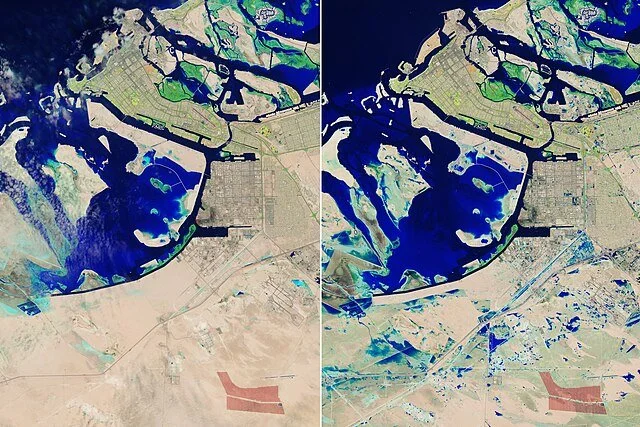April Showers Bring Floods to a Desert
Satellite Images after floods in Dubai (Source: Wanmei Liang for NASA's Earth Observatory)
By Anika Rahman
Dubai, a prominent metropolis of The United Arab Emirates, received unforeseen amounts of rain on April 16, leading to massive flooding. The scale of flooding the city has seen this past week suggests that climate change is to blame.
According to Al Jazeera, Dubai saw “more than a year and a half’s rain in just a few hours” beginning Tuesday, which amounted to 5.59 inches of rain in just 24 hours. Infrastructurally unequipped for such a downpour, Dubai residents and travelers found themselves trapped at home, on the streets, and in Dubai’s international airport, a busy travel hub.
The immediate suspect of such an un-natural disaster was cloud seeding, a practice often employed in the region to combat water shortages. The UAE, located in a dry, desert region, has performed cloud-seeding since the 90s. The process targets moist clouds and instigates rain from them. While cloud seeding indeed causes unnatural amounts of rain, the city has recently managed its endeavors. The incredible rain this past week suggests a larger culprit: climate change.
According to Al Jazeera, experts are pointing their fingers at climate change, citing that “you can’t create rain out of thin air per se and get six inches of water.” For this reason, they believe that this unprecedented weather was “likely due to a normal weather system that was exacerbated by climate change,” not cloud seeding.
A warming planet means warmer oceans. The UAE is situated along the Persian Gulf and the Gulf of Oman. This, along with the hot air of the desert climate, makes for a heightened storm environment, or convection, Al Jazeera reported. Therefore, according to Mark Howden, a director at The Australian National University’s Institute for Climate, Energy and Disaster Solutions, climate change is responsible for the “bigger dumps of rainfall such as what we have just seen in Dubai.”
Meteorologists also note that the storm made its appearance on forecasts days prior, further proving that cloud seeding, which results in almost immediate rainfall, is not at fault. Similarly, Suzanne Gray, a professor of meteorology at the University of Reading, points out that there have been “nearly 100 such events over the southern Arabian Peninsula from 2000 to 2020, with most in March and April,” cited Al Jazeera. What is crucial to note here is that these events occur typically during the rainy season, but meteorologists have observed that they have occurred throughout the century thus far, which further implicates climate change.

